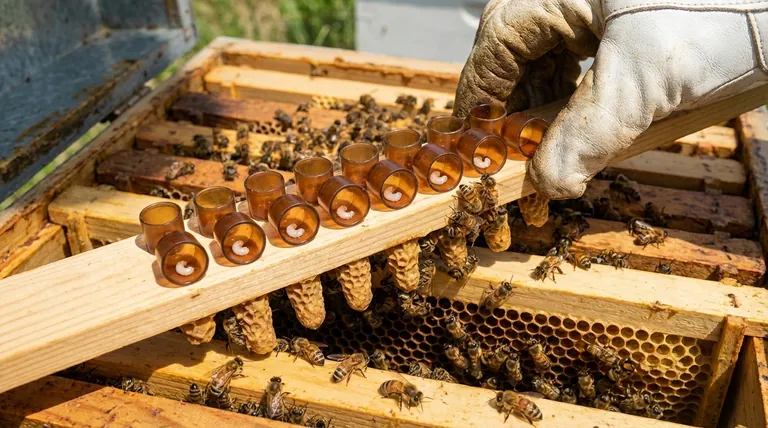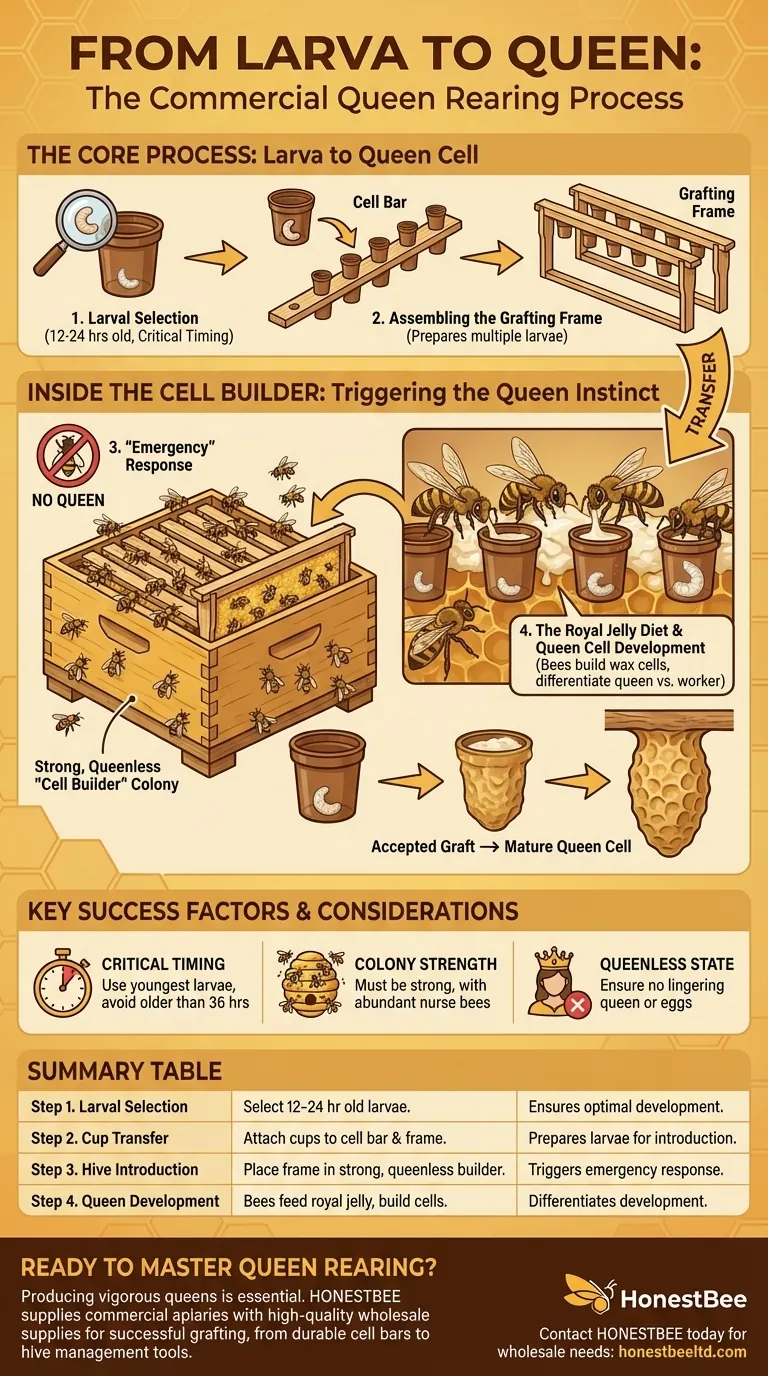Once the eggs in the brown cell cups have hatched, the resulting young larvae are immediately prepared for the next critical stage of queen rearing. The cups are carefully removed from the laying box and attached to a special frame, which is then placed into a "cell builder" honeybee colony to be raised into mature queen cells.
The transfer of these larvae is the pivotal step in queen rearing. It leverages a strong colony's natural instinct to create a new queen by providing them with pre-selected candidates, which the bees then feed a special diet of royal jelly to ensure their development into queens instead of workers.

From Larva to Queen Cell: The Core Process
This entire procedure is a carefully managed process known as "grafting," where a beekeeper manipulates a colony's behavior to produce a desired outcome.
The Importance of the Young Larva
The process begins with selecting larvae that are extremely young, typically just 12 to 24 hours old. At this stage, they are barely visible C-shaped specks. This timing is critical, as only the youngest larvae can be successfully developed into high-quality queens.
What is a Cell Bar?
A cell bar is the piece of equipment that holds the individual brown cell cups. It is typically a wooden or plastic strip with posts or mounts spaced evenly along its length. Each brown cup containing a single larva is affixed to one of these posts.
Assembling the Grafting Frame
Multiple cell bars, each loaded with larvae, are then fitted into a specialized frame. This "grafting frame" is designed to hold several bars at once, allowing a beekeeper to introduce dozens of potential queens into a single hive for rearing.
Inside the Cell Builder: Triggering the Queen Instinct
The prepared grafting frame isn't placed in just any hive. It is introduced to a powerful, specially prepared colony known as a cell builder or starter.
The "Emergency" Response
A cell builder colony is made queenless shortly before the grafting frame is introduced. The absence of a queen and her pheromones triggers an urgent, instinctual "emergency" response among the worker bees to raise a new one.
The Royal Jelly Diet
When the frame of larvae is placed in this queenless hive, the nurse bees immediately identify the young larvae in the cups as ideal queen candidates. They begin to feed them a copious, protein-rich diet of royal jelly, the substance that differentiates a queen's development from a worker's.
Drawing Out the Queen Cell
As the bees feed the larva, they build a large, peanut-shaped wax cell downwards from the plastic cup. The appearance of these distinctive, elongated wax cells is the clear sign that the bees have accepted the graft and are successfully raising the larvae into queens.
Understanding the Trade-offs and Key Considerations
While the process is reliable, success is not guaranteed. It depends on several critical factors that must be managed precisely.
The Critical Timing of Transfer
The single biggest point of failure is using larvae that are too old. Larvae older than about 36 hours will either be rejected by the nurse bees or develop into undersized, poor-quality queens.
The Strength of the Cell Builder
A weak or moderately populated colony will not work. A cell builder must be overflowing with young nurse bees who produce royal jelly. A strong population is required to generate enough heat and food to properly care for dozens of developing queens.
Ensuring a Queenless State
The cell builder must be definitively queenless. If there is a lingering queen, or even a recently laid egg that the bees can use to make their own queen, they will often ignore the larvae presented to them in the cell cups.
How to Apply This to Your Project
Your approach should be guided by your primary goal for rearing queens.
- If your primary focus is maximizing acceptance: Ensure your cell builder colony is densely populated, well-fed, and has been queenless for at least 24 hours before introducing the cells.
- If your primary focus is producing high-quality queens: Select larvae that are as young as possible (barely visible to the naked eye) and ensure they are never allowed to dry out during the transfer process.
- If your primary focus is efficiency: Use a well-designed cell bar system that allows you to quickly and securely transfer dozens of cups into the builder hive with minimal disturbance.
By understanding and managing this carefully orchestrated process, beekeepers can reliably produce new, vigorous queens to sustain and expand their apiaries.
Summary Table:
| Step | Key Action | Purpose |
|---|---|---|
| 1. Larval Selection | Select larvae 12-24 hours old. | Ensures optimal development into high-quality queens. |
| 2. Cup Transfer | Attach cups to a cell bar on a grafting frame. | Prepares dozens of larvae for introduction into the hive. |
| 3. Hive Introduction | Place frame into a strong, queenless 'cell builder' colony. | Triggers bees' emergency response to raise a new queen. |
| 4. Queen Development | Bees feed larvae royal jelly and build wax queen cells. | Differentiates queen development from worker bees. |
Ready to Master Queen Rearing? Producing vigorous queens is essential for a thriving apiary. HONESTBEE supplies commercial apiaries and beekeeping equipment distributors with the high-quality, wholesale-focused supplies needed for successful grafting and queen production—from durable cell bars and grafting frames to essential hive management tools.
Contact HONESTBEE today to discuss your wholesale needs and ensure your queen-rearing operation is a success.
Visual Guide

Related Products
- Brown Nicot Queen Cell Cups for Breeding Queen Bees Beekeeping
- JZBZ Push-In Queen Cell Cups for Beekeeping
- Clear Black Plain Polystyrene Queen Bee Grafting Cell Cups No Lug for Bee Queen Cup
- JZBZ Type Wide Base Plastic Queen Cell Cups for Base Mounting and Queen Rearing
- Stainless Steel Queen Grafting Tool for Beekeeping and Bee Queen Grafting
People Also Ask
- How many cells are given to a nucleus? Understand the One-to-One Rule in Cell Biology
- How does Queen Rearing with JZBZ work? A Reliable System for Consistent Queen Production
- What is the advantage of the Nicot Cupkit system? Secure Your Queen Rearing Success with Batch Protection
- What role does the natural swarming process play in queen rearing? Harness the Swarm Instinct for Better Queens
- What is the benefit of inducing supersedure by giving a queenright colony a protected queen cell? A Seamless Requeening Method











